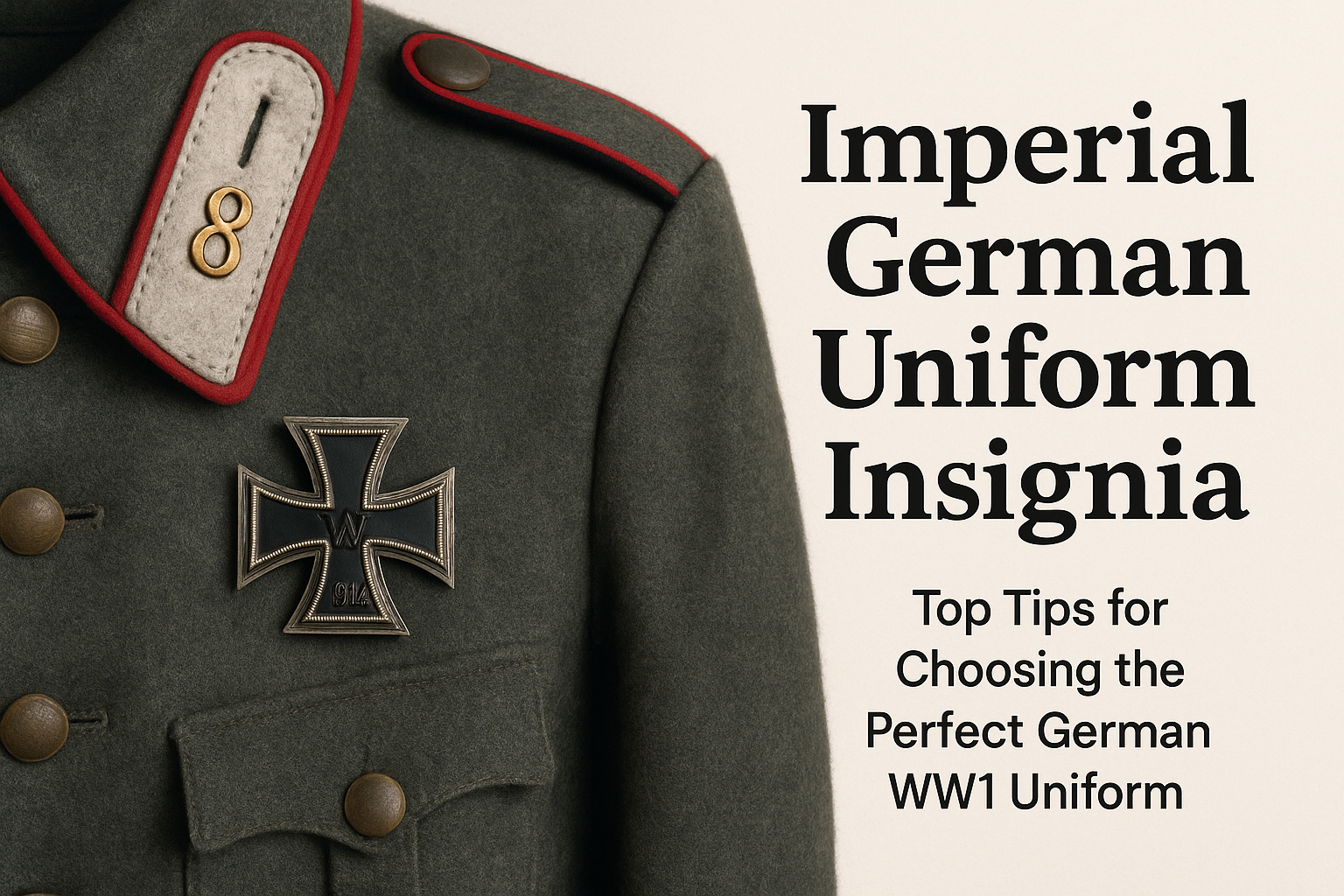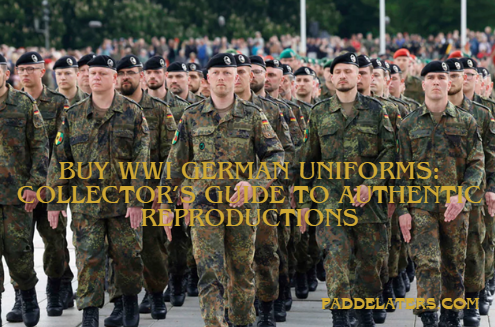
Buy WWI German Uniforms: Collector’s Guide to Authentic Reproductions
Published on Aug 03, 2025
Imperial German Uniform Insignia: A Collector’s Guide to WWI Authenticity
The Legacy of WWI Imperial German Uniform Insignia
The World War I era marked a turning point in military attire—both functionally and symbolically. The imperial German uniform insignia represented more than just military rank; it embodied the tradition, hierarchy, and prestige of the Imperial German Army.
For collectors, reenactors, and history enthusiasts, these uniforms provide a tangible link to a pivotal era. From feldgrau tunics to regimental collar tabs, each detail reflects historical accuracy and craftsmanship that’s become increasingly rare.
At Paddelaters.com, we’ve spent over eight years perfecting our approach to reproducing WWI German uniforms with attention to detail and material authenticity.
Why German WWI Uniforms Matter to Collectors and Reenactors
- Historical Importance: These uniforms tell the story of a militarized empire on the brink of modern warfare.
- Cultural Representation: They offer insights into military ranks, roles, and divisions through insignia like shoulder boards, collar patches, and buttons.
- Reenactment Realism: A well-made reproduction helps reenactors bring history to life with greater credibility.
- Investment Value: Authentic and high-quality reproductions hold value and desirability among collectors.
Key Features of WWI German Army Uniforms
When choosing a high-quality WWI German uniform, pay attention to the following aspects:
1. Authenticity of Insignia
- Proper shoulder boards, collar tabs, and cuff titles.
- Accurate replication of regimental and divisional insignia.
2. Materials and Fabric
- Original uniforms used feldgrau wool, lined interiors, and real brass or pewter buttons.
- Look for thick, durable wool blends that closely mimic originals.
3. Stitching and Craftsmanship
- Hand-finished detailing.
- Correct placement of insignia and buttons.
4. Proper Sizing and Fit
- Historical accuracy doesn’t mean discomfort—sizing should suit modern standards while retaining vintage form.

Buy WWI German Uniforms: Collector’s Guide to Authentic Reproductions
Comparison Table: Officer vs. Enlisted German WWI Uniforms
FeatureOfficer UniformsEnlisted UniformsMaterial | Higher-grade wool, often lighter | Heavier feldgrau wool
Insignia Quality | Embroidered with metallic thread | Woven or printed cloth
Buttons | Gilded or silver-plated | Pewter or matte finish
Pricing Range (USD) | $200–$600 | $120–$300
Availability on Paddelaters.com | ✅ Wide selection | ✅ Extensive range
Explore authentic options:
👉 Explore WWI German Uniforms
Use Cases: Who Wears Imperial German Uniforms Today?
- Reenactors: Participate in WWI reenactments across Europe and North America.
- Museums and Film Studios: Require historically accurate costumes.
- Collectors: Seek investment pieces or rare insignia sets.
- Educators and Historians: Use uniforms to enhance public presentations and exhibitions.
Top Tips for Choosing the Perfect German WWI Uniform
ConsiderationWhy It MattersAuthenticity | Adds credibility for reenactment/collection
Craftsmanship | Determines durability and detail accuracy
Vendor Reputation | Trust established makers like Paddelaters.com
Fit and Comfort | Ensures usability beyond just display
Historical Accuracy | Aligns with specific units or ranks
Learn more in our guide on choosing a high-quality WW1 German uniform.
Insignia to Look Out For
Many confuse WWII German patches or German SS patch styles with WWI insignia. However, the distinctions are clear:
- WWI insignia lacked the stylized and propagandized symbols of the Third Reich.
- Imperial insignia often featured traditional eagles, regimental numbers, and crown motifs.
- Tunic insignia was simpler and emphasized rank and unit rather than ideology.
For an in-depth breakdown, check out our article:
📰 The WWI German Uniform: Exploring Authentic Tunics, Hats, and Historical Legacy
Frequently Asked Questions
1. What does "imperial German uniform insignia" refer to?
It includes the badges, patches, and symbols used on WWI-era German uniforms to denote rank, unit, and service branch.
2. How are WWI German insignia different from WWII German patches?
WWI insignia are more traditional, while WWII German patches introduced Nazi symbolism and more elaborate designs.
3. Can I still buy authentic WWI German uniforms?
Originals are rare and expensive. Reproductions from trusted vendors like Paddelaters.com offer a more accessible option.
4. Where should I place insignia on my WWI German tunic?
Typically on shoulder straps, collar tabs, and occasionally sleeves. Layouts vary by branch and regiment.
5. Are German SS patches related to WWI uniforms?
No. The German SS patch emerged during WWII under Nazi Germany. It has no direct relation to imperial WWI designs.
6. What’s the best way to ensure a uniform is high quality?
Check for:
- Accurate patterns
- Authentic materials
- Vendor reputation
Browse Paddelaters' WWI collection for reliable options.
7. What rank insignia were used in WWI German uniforms?
From enlisted chevrons to officer epaulettes, insignia denoted not just rank but also unit distinctions and role specificity.
Final Thoughts: Reenact History with Confidence
Whether you're outfitting for a reenactment or expanding your historical collection, the right imperial German uniform insignia makes all the difference. By focusing on authenticity, craftsmanship, and trusted sources like Paddelaters.com, you ensure both accuracy and quality in every stitch.
👉 Ready to explore WWI German uniforms?
View the complete collection here
